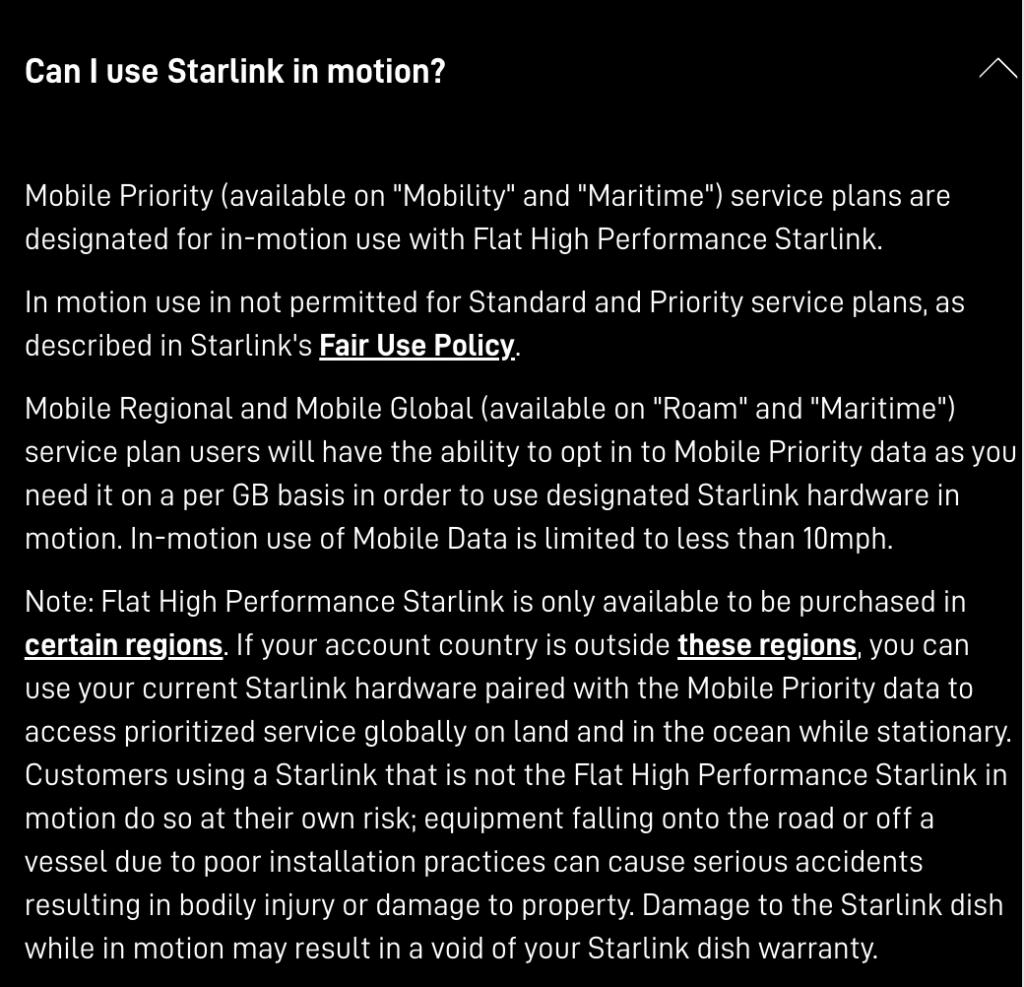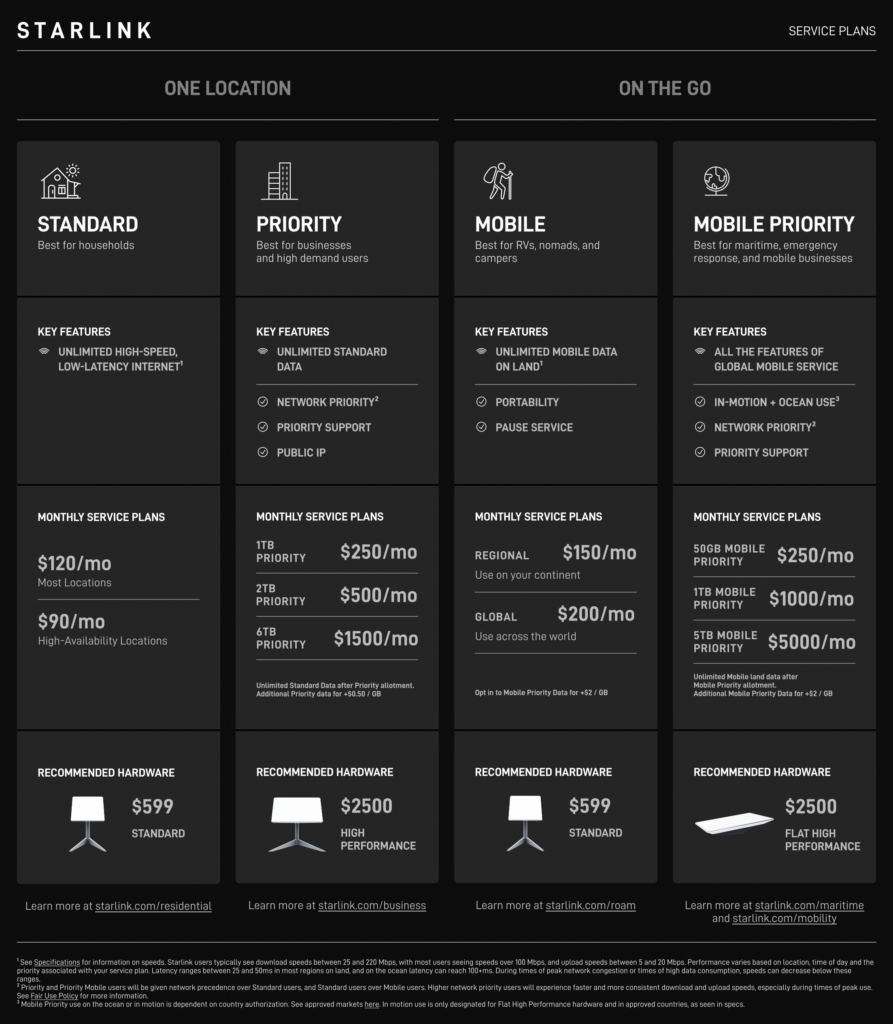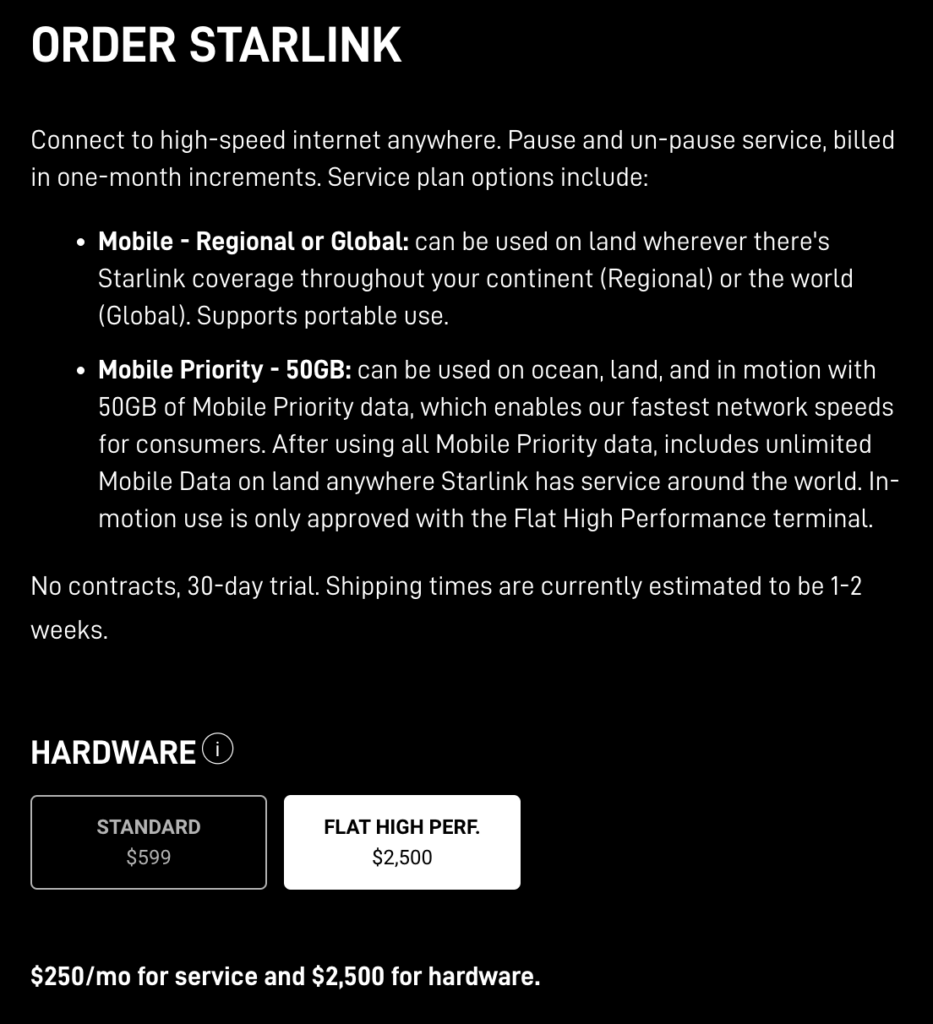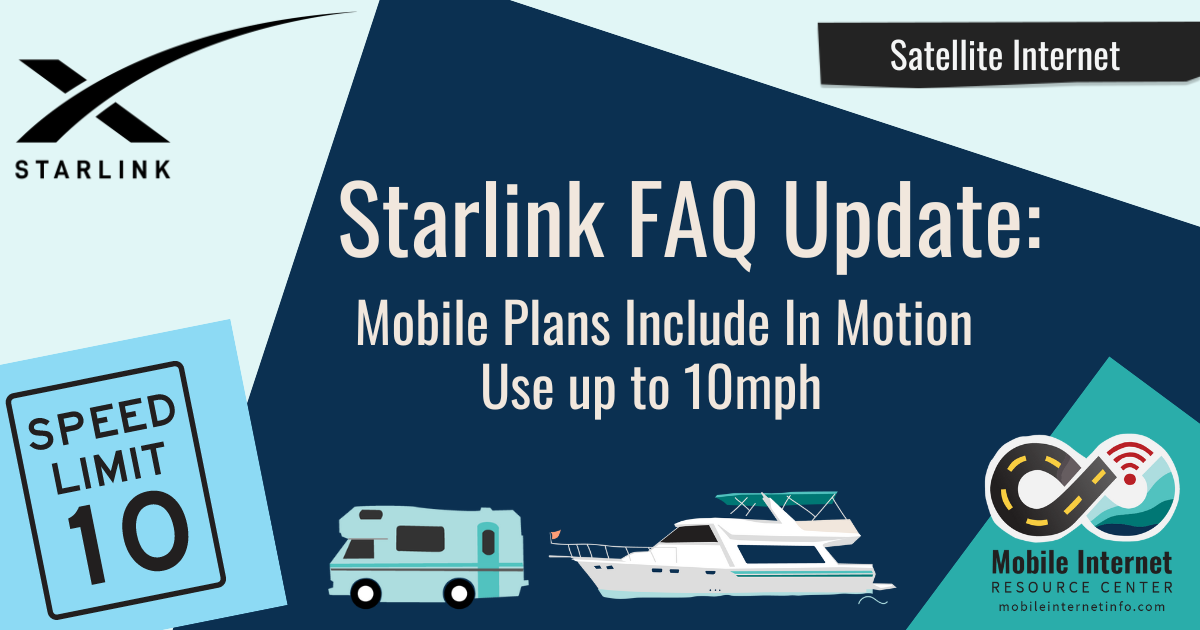Key Points:
- SpaceX has added some clarity around in motion usage of Starlink hardware - for the first time mentioning a 10mph speed limit for in motion "Mobile Data" usage.
- For usage at faster speeds (or on open water crossings), metered "Mobile Priority Data" is called for.
- For boaters concerned about connectivity swinging at anchor near shore or while cruising inland waterways slowly, this explicit 10mph limit is a comforting reassurance that they are operating within SpaceX's rules.
- Open questions remain around how SpaceX will handle RVers who hope to keep connected via Starlink at highway speed.
- The Flat High Performance Starlink system is required for official in motion support, but for the first time the FAQ acknowledges that customers can use the Starlink Standard hardware in motion "at their own risk".
There has been a lot of confusion around Starlink usage while in motion - particularly since SpaceX revamped its plans in May to only officially support in motion Starlink usage via the expensive (and not unlimited) "Mobile Priority" plan.
It has however remained unclear just what the Starlink system considers "motion" to be - especially since SpaceX has not yet begun to consistently block other plans from usage while underway.
Boaters hoping to keep connected while drifting slowly at anchor have been particularly concerned that SpaceX might block even this slight motion at some point.
Now at last - new updates to the official Starlink FAQ's finally shed some clarity, and offer reassurance.
But some open questions remain - particularly for RVers who have purchased Starlink hardware from RV-focused resellers like Winegard and MobileMustHave that still seem to promise unlimited in-motion usage via the $150/mo Starlink Mobile Regional plan.
Table of Contents
Starlink In Motion Use Video
Starlink’s In-Motion FAQ Update
A lot of confusion has resulted from the similar naming of Starlink's "Mobile" and "Mobile Priority" plans - especially since customers with the Mobile plan can opt in to purchase "Mobile Priority" data for $2.00/GB as needed.
Behind the scenes - Starlink defines two types of mobile data:
- Mobile Data - Unlimited usage on land, lower network priority, and supports portability to allow service to automatically connect in new locations.
- Mobile Priority Data - Metered usage. Higher network priority. Officially supports in motion usage. Use in areas marked as water / ocean.
The official Starlink FAQ for the question "Can I use Starlink in motion?" was updated recently to at last explain how unlimited Mobile Data is handled while in motion:
"In-motion use of Mobile Data is limited to less than 10mph."

This is great news for boaters that have been wondering for months if they would be required to opt-in to Mobile Priority for service at anchor or when slowly cruising inland waterways marked as land, typically moving under 10mph.
The FAQ also clarifies that Mobile Regional and Mobile Global service plans will still have the ability to opt-in to Mobile Priority data for official in motion support while traveling faster than 10mph.
This data is currently priced at $2.00/GB or upgrading to a Mobile Priority plan.
Is Starlink Going to Block In-Motion For Non Approved Hardware?
The only consumer Starlink hardware that is officially approved for usage in motion (at any speed) is the $2,500 Starlink Flat High Performance system.
But customers have long noted that the much more affordable ($599) Starlink Standard receiver has mostly performed well in motion too, especially if modified to be flat mounted.
Would Starlink eventually block this hardware connecting if motion is detected?
Based on the latest FAQ changes - it now seems likely that Starlink Standard will remain fully (but unofficially) supported at speeds less than 10mph, and potentially usage will not be actively blocked even at faster speeds when using Mobile Priority data.
This is the first time that SpaceX has ever mentioned using the Starlink Standard receiver while in motion:
"Customers using a Starlink that is not the Flat High Performance Starlink in motion do so at their own risk; equipment falling onto the road or off a vessel due to poor installation practices can cause serious accidents resulting in bodily injury or damage to property. Damage to the Starlink dish while in motion may result in a void of your Starlink dish warranty."
Based on local licensing and regulations - SpaceX may still end up eventually needing to block Starlink Standard usage in motion in some countries.
Whether Starlink decides (or is forced) to block Starlink Standard in motion or not, if official in motion use is something you desire or depend on - you should consider opting for the Flat HP receiver to make sure you always maintain that capability.
Starlink's Mobile Plan Options
In May Starlink simplified and relaunched its service plans, breaking them into four primary offerings:
Starlink Revamps Its Plans & Service Priority Levels – Big Impacts For Mobile Users

For customers who want to travel with Starlink, there are now several options to consider - depending on your needs
Here is our updated summary of the options:
- Starlink Standard - Works only while stationary at your registered service address, but you can manually change your address as needed - but only if there is capacity available at your new service location. A great option for infrequent travelers. $90-120/mo.
- Mobile Regional - Works at up to 10mph, anywhere on your home continent, but only in areas mapped as "land". Unlimited 'best effort' usage. $150/mo
- Mobile Global - Works at up to 10mph worldwide - but only in areas mapped as "land". Unlimited 'best effort' usage. $200/mo
- Mobile Priority - Works in motion at any (reasonable) vehicle speed worldwide including areas marked as ocean - data is higher priority on the Starlink network, and metered. 50GB of Mobile Priority data is available for $250/mo, and there are higher plan offerings up to 5TB. After this is used up the plan reverts to unlimited 'best effort' land service, and is essentially identical to Mobile Global unless additional data is purchased.
The Mobile Regional and Mobile Global plans allow you to opt-in to Mobile Priority access as needed, flipping a switch to start paying $2.00/GB to enable higher priority access, higher speed in motion support, and access on areas mapped as "Ocean" on the Starlink coverage map - typically only needed when traveling far from land.
If you disable Mobile Priority, data is not metered and is back to being unlimited in land areas - but travel speeds will theoretically be limited to 10mph.
For most coastal cruisers and RVers - the manual control of the Mobile Regional or Mobile Global plans will prove to be more affordable and flexible than the $250/mo Mobile Priority plan.
Starlink and RVs at Highway Speed?

RV-focused resellers like Winegard and MobileMustHave are still offering Starlink Flat High Performance systems for sale with the $150/mo Mobile Regional plan, claiming that they enable unlimited in-motion usage at highway speeds.
This is of course what their customers expect - RVers want to be able to keep their passengers entertained with unlimited streaming, and paying $2.00/GB additional for Mobile Priority data is not worthwhile just to help Sponge Bob keep the kids occupied.
The Mobile Regional offering being sold by resellers however is now in direct conflict with the terms of the Mobile Regional plan as described on SpaceX's Starlink site.
It is unclear how this conflict will be worked out, but there are a few possible scenarios.
One possibility is that SpaceX will be treating Starlink hardware sold via Winegard (and other RV market focused resellers) differently than hardware sold directly, letting these resellers officially (and exclusively) offer highway speed unlimited in-motion data.
Or SpaceX could revise their terms or enforcement to officially allow unlimited highway speed usage with the Mobile Regional plan, perhaps only in certain markets.
Or perhaps it is just a matter of notifying existing resellers and customers that the terms are changing - hopefully grandfathering in customers who bought Flat HP systems in good faith expecting that in motion usage would not come with a $2.00/GB price premium.
We have reached out to Winegard - and the only statement on the matter we can get is:
"If there were going to be changes to current customers, I would hope notices would go out like when they’ve changed plans in the past."
We can only hope that SpaceX doesn't yank the rug out too suddenly on anyone.
Conclusion

As usual - Starlink keeps changing (and clarifying) the rules of its plans, often leaving customers guessing just how they apply - and whether the rules will ultimately be enforced.
Certainly for boaters and cruisers, the 10mph clarification is a positive change, and eliminates a lot of questions that have come up in the past few months since the plan changes were introduced.
On the other hand, RVers and other land based nomadic users who wanted official unlimited in-motion use and chose to purchase the much more expensive Flat HP receiver may soon need to also pay for more expensive Mobile Priority Data to continue to keep connected underway.
The new 10mph speed limit isn't being widely enforced yet - so we will have to see how Starlink chooses to move forward.
Will SpaceX somehow grandfather in users that purchased the Flat HP system on a Mobile Regional plan, and who had in-motion usage working above 10 mph prior to this change?
How will things play out for new users that purchase the Flat HP system going forward?
We'll certainly keep our resources updated as we learn more, and as we get reports from users on how and when speed enforcement rolls out.
Related Content at the Mobile Internet Resource Center: Related News Stories








 Mobile Internet Resource Center (dba Two Steps Beyond LLC) is founded by Chris & Cherie of
Mobile Internet Resource Center (dba Two Steps Beyond LLC) is founded by Chris & Cherie of